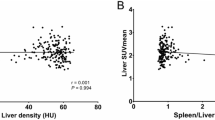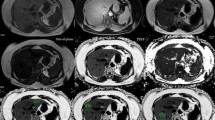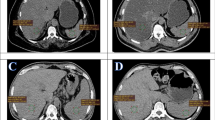Abstract
Objectives
Hepatic steatosis is common but less is known of the heterogeneity of hepatic fat distribution and its clinical significance. Our objective was to measure the regional variabilities within the liver of standardised uptake values (SUV) as potential markers of hepatic fat distribution heterogeneity.
Methods
Twenty-four patients having routine, clinically indicated PET/CT with 18F-FDG and a wide range of fatty liver severity were selected. Maximum SUV (SUVmax), average SUV (SUVave), both calculated using lean body mass, and CT density were measured in 12 × 2-cm diameter ROIs in each patient. SUVave was also measured over the left ventricular cavity (SUVLV). Mean values of SUV indices, their ratios with SUVLV, and CT density in the 12 ROIs were calculated. Regional variabilities of SUV indices were expressed as coefficients of variation (CV; standard deviation/mean). Body mass index (BMI) was estimated from height and body weight, and %body fat and lean body mass from height, weight and gender.
Results
Mean SUVmax/SUVave correlated significantly with mean CT density (r = −0.51; p < 0.02). In contrast, mean SUVmax, mean SUVave and their ratios with SUVLV showed no correlation with CT density. Mean CT density correlated with weight (r = −0.59; p < 0.005), BMI (r = −0.57; p < 0.01) and %body fat (r = −0.49; p < 0.02). Corresponding correlation coefficients for mean SUVmax/SUVave were 0.74 (p < 0.001), 0.65 (p < 0.001) and 0.46 (p < 0.03). In contrast, mean SUVmax, mean SUVave and their ratios with SUVLV showed no correlation with BMI, weight and %body fat. The CV of SUVmax/SUVave (r = −0.67; p < 0.001), but not the CVs of SUVmax or SUVave, correlated with mean CT density.
Conclusions
SUVmax/SUVave and CT density are markers of hepatic steatosis. The regional variability of SUVmax/SUVave may be a marker of hepatic fat distribution heterogeneity. The novel concept is introduced that hepatic fat distribution heterogeneity may be a marker of hepatic pathology and of clinical value, and deserves further exploration with texture analysis.




Similar content being viewed by others
References
Anstee QM, McPherson S, Day CP. How big a problem is non-alcoholic fatty liver disease? Br Med J. 2011;343:d3897.
Williams CD, Stengel J, Asike MI, Torres DM, Shaw J, Contreras M, et al. Prevalence of nonalcoholic fatty liver disease and nonalcoholic steatohepatitis among a largely middle-aged population utilizing ultrasound and liver biopsy: a prospective study. Gastroenterology. 2011;140:124–31.
Bohte AE, van Werven JR, Bipat S, Stoker J. The diagnostic accuracy of US, CT, MRI and 1H-MRS for the evaluation of hepatic steatosis compared with liver biopsy: a meta-analysis. Eur Radiol. 2011;21:87–97.
Agopian VG, Kaldas FM, Hong JC, Whittaker M, Holt C, Rana A, et al. Liver transplantation for non-alcoholic steatohepatitis: the new epidemic. Ann Surg. 2012;256:624–33.
Musso G, Gambino R, Cassader M, Pagano G. Meta-analysis: natural history of non-alcoholic fatty liver disease (NAFLD) and diagnostic accuracy of non-invasive tests for liver disease severity. Ann Med. 2011;43:617–49.
Bural GG, Torigian DA, Burke A, Houseni M, Alkhawaldeh K, Cucchiara A, et al. Quantitative assessment of the hepatic metabolic volume product in patients with diffuse hepatic steatosis and normal controls through use of FDG-PET and MR imaging: a novel concept. Mol Imaging Biol. 2010;12:233–9.
Abikhzer G, Alabed YZ, Azoulay L, Assayag J, Rush C. Altered hepatic metabolic activity in patients with hepatic steatosis on FDGPET/CT. Am J Roentgenol. 2011;196:176–80.
Lin CY, Lin WY, Lin CC, Shih CM, Jeng LB, Kao CH. The negative impact of fatty liver on maximum standard uptake value of liver on FDG PET. Clin Imaging. 2011;35:437–41.
Abele JT, Fung CI. Effect of hepatic steatosis on liver FDG uptake measured in mean standard uptake values. Radiology. 2010;254:917–24.
Keramida G, Potts J, Bush J, Dizdarevic S, Peters AM. Hepatic steatosis is associated with increased hepatic FDG uptake. Eur J Radiol. 2014;83:751–5.
Keramida G, Potts J, Bush J, Verma S, Dizdarevic S, Peters AM. Accumulation of 18F-fluorodeoxyglucose in the liver in hepatic steatosis. AJR Am J Roentgenol. 2014;203:643–8.
Ricci C, Longo R, Gioulis E, Bosco M, Pollesello P, Masutti F, et al. Noninvasive in vivo quantitative assessment of fat content in human liver. J Hepatol. 1997;27:108–13.
Sugawara Y, Zasadny KR, Neuhoff AW, Wahl RL. Re-evaluation of the standardized uptake value for FDG: variations with body weight and methods for correction. Radiology. 1999;213:521–5.
Keramida G Hunter J, Dizdarevic S, Peters AM. The appropriate whole body index on which to base standard uptake value in 2-deoxy-2-[18F]fluoro-d-glucose PET. Br J Radiol (in press).
Boyce CJ, Pickhardt PJ, Kim DH, Taylor AJ, Winter TC, Bruce RJ, et al. Hepatic steatosis (fatty liver disease) in asymptomatic adults identified by unenhanced low-dose CT. Am J Roentgenol. 2010;194:623–8.
Zeb I, Li D, Nasir K, Katz R, Larijani VN, Budoff MJ. Computed tomography scans in the evaluation of fatty liver disease in a population based study: the multi-ethnic study of atherosclerosis. Acad Radiol. 2012;19:811–8.
Decarie PO, Lepanto L, Billiard JS, Olivié D, Murphy-Lavallée J, Kauffmann C, et al. Fatty liver deposition and sparing: a pictorial review. Insights Imaging. 2011;2:533–8.
Boer P. Estimated lean body mass as an index for normalization of body fluid volumes in man. Am J Physiol. 1984;247:F632–5.
Layer G, Zuna I, Lorenz A, Zerban H, Haberkorn U, Bannasch P, et al. Computerized ultrasound B-scan texture analysis of experimental diffuse parenchymal liver disease: correlation with histopathology and tissue composition. J Clin Ultrasound. 1991;19:193–201.
House MJ, Bangma SJ, Thomas M, Gan EK, Ayonrinde OT, Adams LA, et al. Texture-based classification of liver fibrosis using MRI. J Mag Res Imaging. 2015;41:322–8.
Green LA, Gambhir SS, Srinivasan A, Banerjee PK, Hoh CK, Cherry SR, et al. Noninvasive methods for quantitating blood time-activity curves from mouse PET images obtained with fluorine-18-fluorodeoxyglucose. J Nucl Med. 1998;39:729–34.
Keramida G, Dizdarevic S, Bush J, Peters AM. Quantification of tumour 18F-FDG uptake: normalise to blood glucose or scale to liver uptake? Eur Radiol (in press).
Keramida G, Peters AM. FDG accumulation is increased in hepatic steatosis. J Nucl Med 2015; 56 (suppl 3):412P (abstract).
Liu G, Li Y, Hu P, Cheng D, Shi H. The combined effects of serum lipids, BMI, and fatty liver on 18F-FDG uptake in the liver in a large population from China: an 18F-FDG-PET/CT study. Nucl Med Commun. 2015;36:709–16.
Erselcan T, Turgut B, Dogan D, Ozdemir S. Lean body mass-based standardized uptake value, derived from a predictive equation, might be misleading in PET studies. Eur J Nucl Med. 2002;29:1630–8.
Mir AH, Hanmandlu M, Tandon SN. Texture analysis of CT-images for early detection of liver malignancy. Biomed Sci Instrum. 1995;31:213–7.
Chicklore S, Goh V, Siddique M, Roy A, Marsden PK, Cook GJ. Quantifying tumour heterogeneity in 18F-FDG PET/CT imaging by texture analysis. Eur J Nucl Med Mol Imaging. 2013;40:133–40.
Acknowledgments
We are grateful to Professor Gary Cook and Dr Muhammad Siddique for helpful advice.
Author information
Authors and Affiliations
Corresponding author
Ethics declarations
Conflict of interest
None to declare.
Rights and permissions
About this article
Cite this article
Keramida, G., Hunter, J., Dizdarevic, S. et al. Heterogeneity of intrahepatic fat distribution determined by 18F-FDG PET and CT. Ann Nucl Med 30, 200–206 (2016). https://doi.org/10.1007/s12149-015-1045-8
Received:
Accepted:
Published:
Issue Date:
DOI: https://doi.org/10.1007/s12149-015-1045-8




